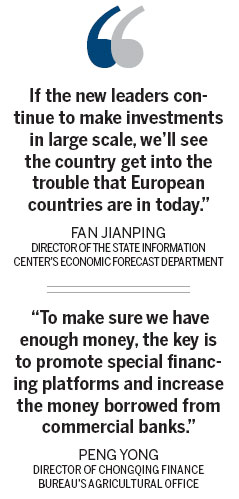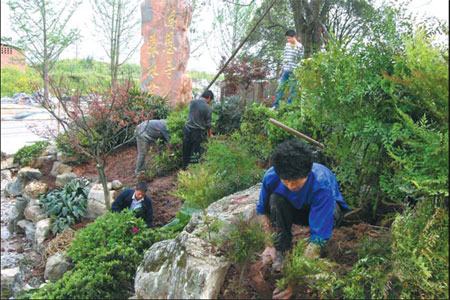Will fresh stimulus cash spur growth?
Updated: 2012-01-12 08:01
By Chen Jia and Wei Tian (China Daily)
|
||||||||

|
Workers fit scaffolding at a construction site as the sun sets in Rizhao, East China's Shandong province. Chen Weifeng / for China Daily |
|
Gardeners plant trees and flowers at the Hong En Si Park in Chongqing in 2009. The park has become famous for its 57 varieties of 10,000 sweet osmanthus. He Zhongrong / for China Daily |

With vow to keep spending on roads, railways and west, investment may be a key driving force
CHONGQING / BEIJING - From the top of a 400-meter-high artificial hill in Hong En Si Park, visitors can see across the Yangtze River to the hundreds of bulldozers clearing the way for new buildings in the concrete jungle that is Chongqing.
Construction of the 76-hectare park in this southwestern municipality was largely finished in May 2009, but workers are still on-site completing surrounding roads, while extra features such as a children's play area are still waiting for the green light.
More than 1 billion yuan ($158.3 million) has already been spent on converting the land, once home to about 380,000 people. The money has gone toward, among other things, 10,000 sweet osmanthus seedlings and a Tang Dynasty-style pavilion.
Since 2008, Chongqing has aimed to inject 48 billion yuan, about 5.8 percent of its GDP in 2010, in expanding plantation coverage and infrastructure construction by 2017, according to Ding Lirong, deputy director of the municipal finance bureau.
Local authorities had hoped such projects would increase investment and ferment GDP growth, at the same time as improving the environment.
And Chongqing is not the only place where officials have shown a great interest in stimulating economic growth with fixed-asset investment. In the first 11 months of last year, urban fixed-asset investment nationwide reached 14.51 trillion yuan, an increase of 24.5 percent on 2010, data from the National Bureau of Statistics (NBS) show.
During the annual Central Economic Work Conference last month, leaders vowed to continue leaning toward key areas such as infrastructure, railways, environmental protection, emerging industries and the development of western China in 2012, signaling that investment could still be the main driver to maintain momentum for the world's second-largest economy amid weak global economic recovery.
With the worsening eurozone debt crisis and the fact that the United States' economy is recovering slower than expected, analysts at international financial institutions have downgraded their expectations for China's economic growth this year, largely because of the sharp decline in exports during the past few months.
The country's GDP growth rate may drop to 7.5 percent in the first quarter of 2012, down from the 8.3 percent predicted in the last quarter of 2011, said Stephen Green, senior economist at Standard Chartered Bank. The figure for the period July to September last year was 9.1 percent.
A research note from the Bank of Communications said that China's monetary policy may continue to loosen this year to avoid an economic "hard landing".
Lending by banks is expected to increase, with the aim to boost investment, the note said. New loans could climb to 8.5 trillion yuan, compared with 7.5 trillion yuan last year.
"If a new increase in investment (by the central government) occurs it would be appropriate, given that the external situation for China's economy is negative," John Ross, economist and a visiting professor at Shanghai Jiao Tong University, told China Daily in an e-mail. "However, a very large-scale increase in investment like the 2008 stimulus package is not called for."
Political shifts
Planning for Hong En Si Park started in July 2005. However, because of a shortage of funds, construction had to be delayed until February 2008, following a local government reshuffle.
Fan Jianping, director of the State Information Center's economic forecast department, said that the pulse of a country's economic cycle is often synchronous with its power shifts, a statement that seems to be proved right by statistics.
"The second and third year of every Five-Year Plan period, which see obvious investment booms, are also the years for Party congresses and government elections," said Fan in Beijing. "That data is often used to show the impact of power transfers on China's economic development."
In 2008, one year after a central governmental reshuffle, total fixed-asset investment nationwide was 17.28 trillion yuan, 25.9 percent higher than in 2007, according to NBS data. The year-on-year increase in 2007 was 24.8 percent.
In response to the global financial crisis of 2008, the third year of the 11th Five-Year Plan (2006-10) period, the State Council approved a stimulus package of 4 trillion yuan to protect the economy against a crushing slowdown. A year later, fixed-asset investment surged by 30 percent, the highest rate in the last decade. It slowed to 23.8 percent in 2010.
This economic cycle was also evident in the period from 1997 to 2001.
However, the phenomenon may not be repeated in the 12th Five-Year Plan (2011-15) period, Fan said, explaining that investment growth has been "abnormal" in recent years.
High inflation and surging housing prices are two obstacles that may cause Chinese authorities to think before taking another step toward investment stimulus, although there have been signs that these factors are cooling, Fan said. He added that the consequences of the 4 trillion yuan package may also help China's economy if investment grows quickly.
Wang Tao, head of China economic research at UBS Securities, pointed out that the central government's annual economic conference did not stress the advancement of urbanization as it has before.
"Instead, the conference emphasized the projection of social welfare and creating more job opportunities for migrant workers, which indicates that increasing investment may no longer be the most important task to sustain a high growth rate," she said.
Li Qiang, deputy director of the NBS, admitted that local governments do influence investment data, as GDP is the most important assessment criterion for their work.
China's fixed-asset investment statistics are given to the NBS by authorities, rather than companies, which raises the risk of fake data, Li said.
Risky business
The main contractor on the Hong En Si Park project, Chongqing Construction Engineering Group, had credit of 13.48 billion yuan by the end of 2008, up from 10.43 billion yuan in 2007. Meanwhile, its debt accounted for 90.34 percent of its assets, climbing 2.52 percentage points from 2007.
By the end of September 2010, its debt reached 24.93 billion yuan, 88.93 percent of its total assets.
Most of the company's projects for the municipal government have limited profitability, such as Hong En Si Park, which is free to the public, except on holidays.
"This company has relatively high debt risks," said a report from Dagong Global Credit Rating, which added that the pressures facing Chongqing's financing platform could mean debt default risks for the contractor, too.
"We have financial difficulties, as the investment is huge," said Peng Yong, director of the city finance bureau's agricultural office. "To make sure we have enough money, the key is to promote special financing platforms and increase the money borrowed from commercial banks."
Deputy Secretary-General of Chongqing Zhao Qiang told Reuters that, by the end of September 2011, credit from the local financing platform was 180 billion yuan, 20 percent of the city's 980 billion yuan GDP. "Currently, it is safe," he said.
According to data from the National Audit Office, the Chinese government has a debt-to-GDP ratio of 43.9 percent, which is still lower than the internationally recognized "fire line" of 60 percent. A central audit in June 2011 showed there are 6,576 investment projects across China, putting total debt at 4.97 trillion yuan.
However, experts with the Ministry of Finance said that the debt default risks are increasing, as 20 percent of governments at municipal level already have a debt-to-GDP ratio of more than 100 percent.
Analysts say the previous injection of money by the central government has unbalanced the books of local authorities and spurred the country's banks to lend.
Some government-led projects, such as highways in Gansu province and a grand stadium in Hunan province, have seen a growing debt level, leading to questions on the sustainability of such investments.
"If the new leaders continue to make investments in large scale, we'll see the country get into the trouble that European countries are in today," said Fan at the State Information Center.
Some economists predict the investment pace may continue to slow this year, although local governments will reshuffle again.
"A modest investment increase would be appropriate to counter the international situation," said Ross at Standard Chartered Bank. "Investment is expected to increase in affordable social housing."
Wang at UBS Securities added that the continued strong growth in social -housing construction and investment is expected to partly offset the weakness in the property market.
Investment in social housing can help prevent a hard landing, and total property investment may grow by as much as 20 percent this year, Wang added.
China Daily
(China Daily 01/12/2012 page7)

 Relief reaches isolated village
Relief reaches isolated village
 Rainfall poses new threats to quake-hit region
Rainfall poses new threats to quake-hit region
 Funerals begin for Boston bombing victims
Funerals begin for Boston bombing victims
 Quake takeaway from China's Air Force
Quake takeaway from China's Air Force
 Obama celebrates young inventors at science fair
Obama celebrates young inventors at science fair
 Earth Day marked around the world
Earth Day marked around the world
 Volunteer team helping students find sense of normalcy
Volunteer team helping students find sense of normalcy
 Ethnic groups quick to join rescue efforts
Ethnic groups quick to join rescue efforts
Most Viewed
Editor's Picks

|

|

|

|

|

|
Today's Top News
Health new priority for quake zone
Xi meets US top military officer
Japan's boats driven out of Diaoyu
China mulls online shopping legislation
Bird flu death toll rises to 22
Putin appoints new ambassador to China
Japanese ships blocked from Diaoyu Islands
Inspired by Guan, more Chinese pick up golf
US Weekly

|

|








